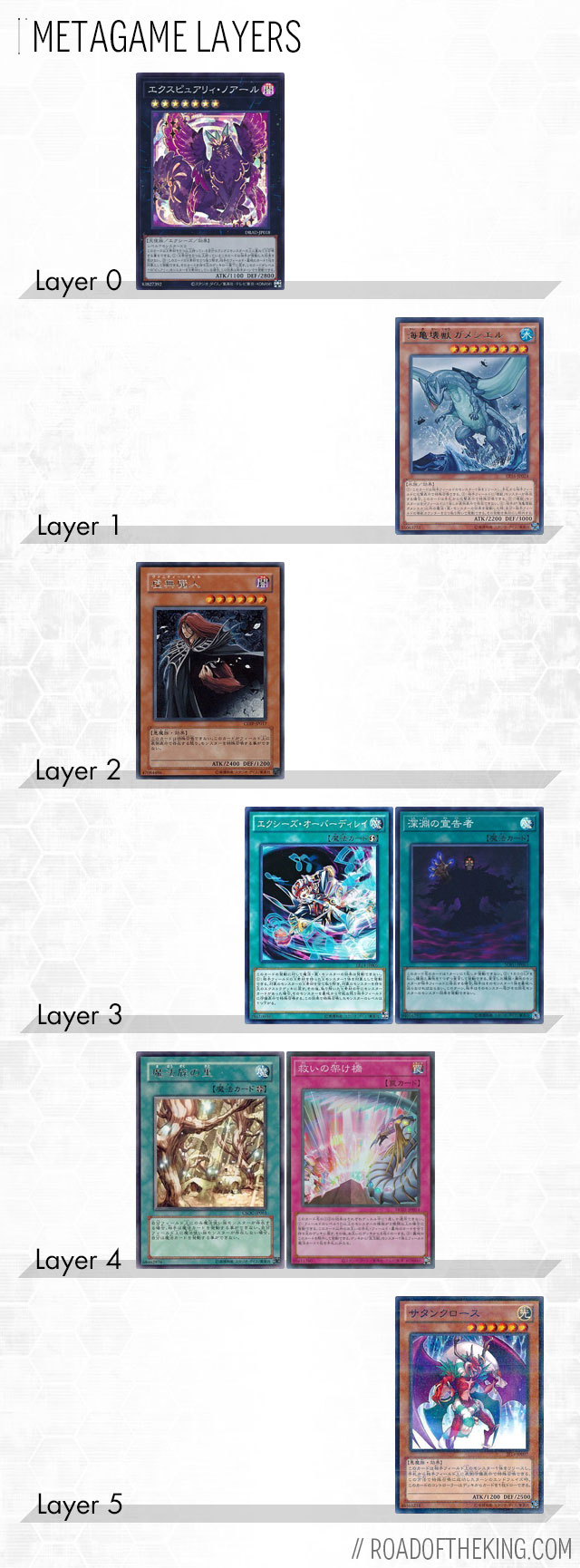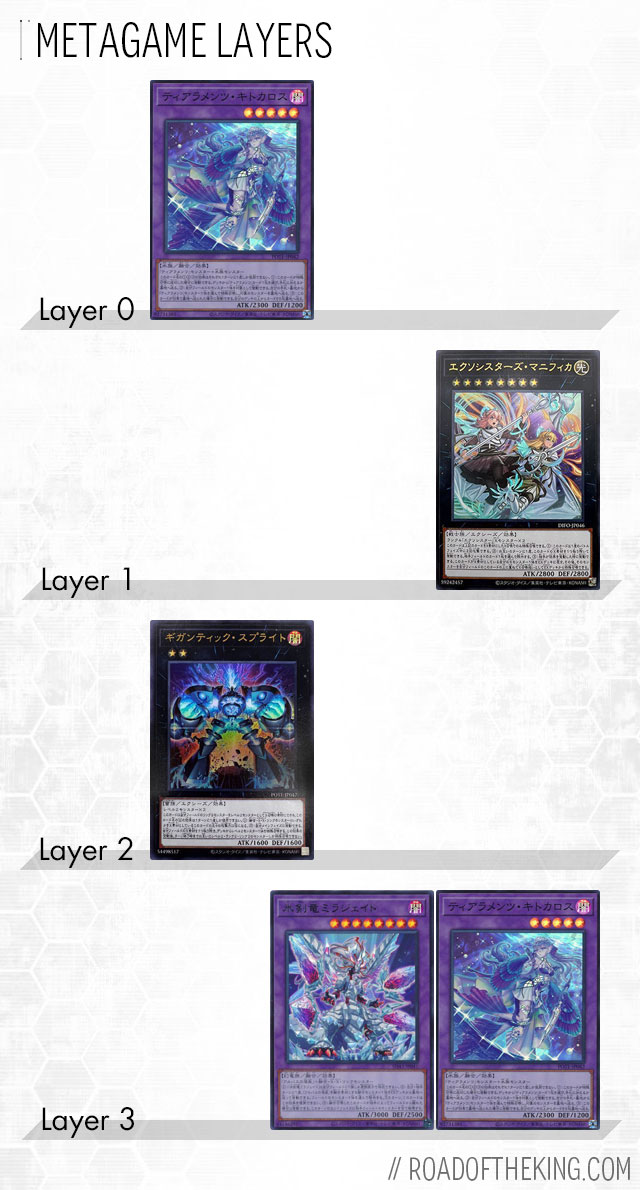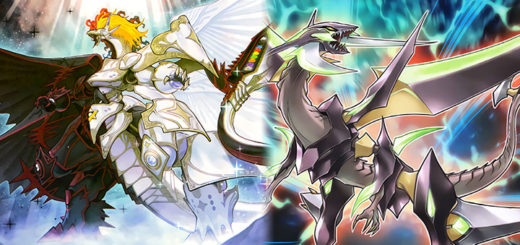Metagame Layers
In the Yu-Gi-Oh! OCG, the metagame describes the spread of decks played in the format. Players’ tendencies and perception of the matchups affects their choice of cards and deck. The metagame is not concrete, but rather it evolves gradually as players’ understanding of the format improves with more experience.
Case Study: OCG 2023.01 Purrely
A significant part of deckbuilding involves reading the metagame and adjusting the deck accordingly. Tech cards to counter popular decks could be played to disrupt the opponent. Correspondingly, counter tech could also be played to prevent your deck’s gameplan from being interrupted.
Purrely in the OCG 2023.01 and OCG 2023.04 formats is an excellent case study of how tech choices change as the metagame adapts.

The release of Cyberstorm Access brought along 2 new Purrely support cards in Purrelyly and Purrely Sleepy Memory. This greatly boosted Purrely and allowed them to compete among the top contenders.
Layer 0 is Expurrely Noir, the main threat that Purrely puts out.
Layer 1 is the initial response to Expurrely Noir in the form of Kaiju monster. Expurrely Noir is unaffected by the opponent’s activated effects while it has 5 or more Xyz materials, but a Kaiju monster such as Gameciel, the Sea Turtle Kaiju would be able to Tribute Expurrely Noir for its Special Summon.
Layer 2 is the counterplay to Kaiju monster in the form of Vanity’s Fiend. While Vanity’s Fiend is on the field, neither player can Special Summon monsters. This effectively prevent the opponent from Special Summoning Kaiju monsters by Tributing Expurrely Noir.
Layer 3 sees Xyz Encore and Herald of the Abyss being brought in to remove Expurrely Noir. These two removal Spells could be played while Vanity’s Fiend is on the field, and would eventually become the standard Side Deck choice against Expurrely Noir.
Layer 4 is the counterplay to Xyz Encore and Herald of the Abyss in the form of Secret Village of the Spellcasters. Rainbow Bridge of Salvation would be used as discard fodder for the Purrely Quick-Play Spells, and it would be able to fetch out Secret Village of the Spellcasters. The Level 1 Purrely and Purrelyly would be used to Xyz Summon Slacker Magician, which is a Spellcaster monster to enable Secret Village of the Spellcasters. Slacker Magician cannot be destroyed by battle, and could negate any card or effect that targets it.
Layer 5 sees a return to Kaiju monster type of removal in the form of Santa Claws. Similar to Gameciel, the Sea Turtle Kaiju, Santa Claws could Special Summon itself to the opponent’s field by Tributing 1 of their monsters. However, there is a slight difference in that Gameciel, the Sea Turtle Kaiju is Special Summoned in Attack Position, whereas Santa Claws is Special Summoned in Defense Position. This allows a Purrely Xyz Monster to attack Santa Claws and survive the battle, which could then be used to Xyz Summon Divine Arsenal AA-ZEUS – Sky Thunder during Main Phase 2. Santa Claws also enables an One-Turn-Kill with Epurrely Happiness attacking it multiple times, by using Purrely Delicious Memory effect to make Santa Claws cannot be destroyed by battle until the end of the next turn, and Epurrely Beauty effect to switch it to Attack Position.
The metagame evolves step by step, and it is important to stay exactly one step ahead of it. If your local metagame is still at Layer 1 using Kaiju monsters, but you are at Layer 4 using Secret Village of the Spellcasters, then you have a mismatch and you would find that Secret Village of the Spellcasters does nothing against the opponent’s Gameciel, the Sea Turtle Kaiju.
Case Study: Master Duel WCS 2023 Qualifiers Tearlaments
Deck choice also involves reading the metagame. The decks to beat and counter decks could form Metagame Layers.
Master Duel WCS 2023 Qualifiers is a great case study of how deck choices change as the metagame adapts.

Layer 0 is Ishizu Tearlaments. Without a doubt, Ishizu Tearlaments was the dominant deck in the format and many players were on them during Stage 2 Day 1.
Layer 1 is Exosister, a strong counter pick against Tearlaments. By the end of Day 1, the top players were mostly on Tearlaments. To stay one step ahead of the metagame, some players switched over to Exosister on Day 2 to prey on Tearlaments.
Layer 2 is Spright, a counter pick to Exosister. On Day 3, Melffy Spright emerged as the final choice to close out the Master Duel WCS 2023 Qualifiers. Spright fared better against Exosister, and was heavily teched out with Dimension Shifter and Ghost Reaper & Winter Cherries against Tearlaments.
Layer 3 is Branded Ishizu Tearlaments, an innovation by Kobanawa Tasuku (たすく). Tearlaments was good against Spright, and the Branded package was an elegant solution to Exosister. Mirrorjade the Iceblade Dragon Quick Effect is a non-targeting effect that chooses the monster to banish on resolution. This makes Mirrorjade the Iceblade Dragon a great answer against Exosisters Magnifica. If Exosisters Magnifica chained with its Quick Effect to Special Summon another Exosister Xyz Monster, the resulting Exosister Xyz Monster would be banished instead.
Tasuku was so far ahead of the competition that he finished in rank 1st globally while having almost 5000 Duelist Points up over the rank 2nd player. Incredibly, he also participated in the “YCSJ Tokyo 2023” during Stage 2 Day 2, meaning he spent less time grinding out but rather rely on having a high win rate to stay at the top.
Master Duel Duelist Cup and Master Duel WCS Qualifiers are a test of the players’ ability to read the metagame. At the high ratings, the metagame would shift between days to days. The key to moving up in Duelist Points and maintaining at the top and is to stay ahead of the metagame, by playing the appropriate tech and counter tech to edge out the competition. Several players that fell off during the race in Stage 2 were slow to notice and adapt to the changing metagame, allowing other players to overtake them.
Reading the Metagame
World Championship 2019 is a noteworthy example of how both Champion and Finalist have correctly read the metagame and teched Mind Control in the Main Deck accordingly. Mind Control is fantastic in the Salamangreat mirror match for taking your opponent’s Salamangreat monsters to use as materials to Link Summon your own Salamangreat Link Monsters. Mind Control is also an answer against the opponent’s Thunder Dragon Colossus.
This is a common trend among many top winning decks. Very often the winning players had made a correct read on the metagame and built the deck specifically for that tournament. As the deck has been built for that tournament in a certain Metagame Layer, the exact same build brought to another tournament in a different Metagame Layer may not fare as well. This is something to consider when evaluating winning deck lists.
Element of surprise is also a powerful factor in catching the metagame. “Japan Championship 2022” saw Dracoslayer finished in 2nd and 4th, an astonishing feat during the OCG 2022.07 format which was dominated by Ishizu Tearlaments. This was the first time Dracoslayer made the top cut of a tournament, but it would also be their only notable achievement. This Dracoslayer build is heavily teched against Tearlaments, it aims to turbo out Abyss Dweller and sides in Keldo the Sacred Protector and Mudora the Sword Oracle to beat Tearlaments. A significant part of Dracoslayer’s success in the “Japan Championship 2022” was that most opponents had no idea about Dracoslayer and were using their ‘hand traps’ inefficiently. After the “Japan Championship 2022” is over and news of Dracoslayer topping spread through the community, players studied and learnt to beat the deck, and Dracoslayer fell off the metagame.
Conclusion
The metagame is a continuous process that evolves and adapts, forming multiple metagame layers of techs and counter techs. One of the most exhilarating aspect of competitive Yu-Gi-Oh! OCG is to read the metagame, make the correct metagame call by running the appropriate tech cards, and then achieve victory with that deck.
This is, in essence, metagaming.








nice
I want more of these articles: technical, explanation, insight, overview… not just some tourneys recap with bunch of decklists (I mean the number of both types should be equal)